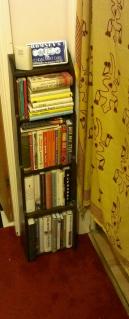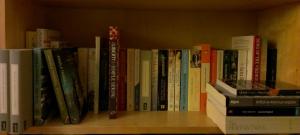 I think this will be the last of my All Virago / All August reviews, because although I’m planning to start “The Last Kings of Sark” today, I don’t think I’ll get it finished. I’ve done pretty well, though. Well – I did make A MISTAKE with one … I picked “Wartime Women” ooff the TBR to add to the AV/AA one, and you can see why in the middle of this picture – it’s GREEN, Virago Green, and it’s about women … and it came from a friend from the LibraryThing Virago Group, too (although the mistake is not her fault in the slightest, as she also had lots of other non-Viragoes – it was my assumption alone!). Anyway, I’ve put that one aside to finish next month. I did start “She Knew She Was Right” but I didn’t take to it for some reason. So apart from those, I’ve now read or started everything in the AV/AA pile! Not bad going!
I think this will be the last of my All Virago / All August reviews, because although I’m planning to start “The Last Kings of Sark” today, I don’t think I’ll get it finished. I’ve done pretty well, though. Well – I did make A MISTAKE with one … I picked “Wartime Women” ooff the TBR to add to the AV/AA one, and you can see why in the middle of this picture – it’s GREEN, Virago Green, and it’s about women … and it came from a friend from the LibraryThing Virago Group, too (although the mistake is not her fault in the slightest, as she also had lots of other non-Viragoes – it was my assumption alone!). Anyway, I’ve put that one aside to finish next month. I did start “She Knew She Was Right” but I didn’t take to it for some reason. So apart from those, I’ve now read or started everything in the AV/AA pile! Not bad going!
Angela Thirkell – “Pomfret Towers” (Virago)
(21 January 2014 – from Ali)
Yet more Thirkell, and this one links charmingly to the first two, since we’re at the residence of the brother of Lady Emily from “Wild Strawberries” and Mrs Morland from “High Rising” and her publisher, Adrian Coates, are also mentioned. Even without this, it’s altogether an exquisitely charming book, with a gauche and painfully shy heroine who you can’t help adoring, who has to suffer the agonies of a local house party (local, but with no chance of escape) at the home of the irascible and crusty Lord Pomfret, alongside his diffident and equally shy heir, who we all come to love, too, and various difficult and disruptive relatives and locals, as well as the odd shrieking girl and red-faced man. Luckily, some friends and allies are there, too, and there are enough lovely characters to make a good balance with the horrendous ones, and a lot of good-hearted generousness on the part of both author and characters.
All is beautifully drawn, and the contrast between two lady authors is beautifully and highly amusingly done. I really didn’t want this to end, while desperate to know who was going to end up with whom. A lovely read. Here’s Ali’s own review of the book, by the way!
Mary Webb, “The House in Dormer Forest” (Virago)
(25 January 2014 – Shakespeare Hospice Bookshop, Stratford)
I do love Mary Webb with her rural settings like those of Hardy and Brett Young (with the landscape playing an active role in the atmosphere and events of the story) and an intriguing mysticism and insight into the interior and exterior of family and community relationships.
In this dense novel, the house in which the Darke family exist (ingrained in age-old patterns and acting as a unit rather as individuals, they can’t really be said to be living) seems to exert its own impassive yet claustrophobic influence over the family, which in turn has bound itself too fast in its own web of special conventions and ties of (mostly) hatred. Jasper fights against his religion, Ruby is trapped between her need for convention and her own desires, and Peter is forced to rebel, while quiet Amber truly communes with nature and thus surely deserves a better fate than being the unattractive odd one out, regarded with disdain by her manipulative cousin, Catherine (her of the “long eyes”).
Although there’s a brooding matriarch given to shouting out Biblical phrases and a scary family retainer, Enoch, Mary Webb does not deserve her reputation of being melodramatic and humourless, unfortunately brought up by her association with Stella Gibbons’ “Cold Comfort Farm” (which Gibbons herself claimed was based on an amalgam of ‘countryside misery’ novels, including Hardy and others as well as Webb). The descriptions of nature are truly beautiful, and this is a very human, understanding and sometimes funny book. Webb certainly doesn’t take herself or her characters too seriously, undermining them with touches of playful or vicious satire. A better read than people would think: luckily, I already knew I was going to enjoy it.
—
I’ve managed to acquire only one new book, Nick Hornby’s “Polysyllabic Spree”, from the BookCrossing meetup, so my TBR is looking amazing, as you will see tomorrow …









Recent comments